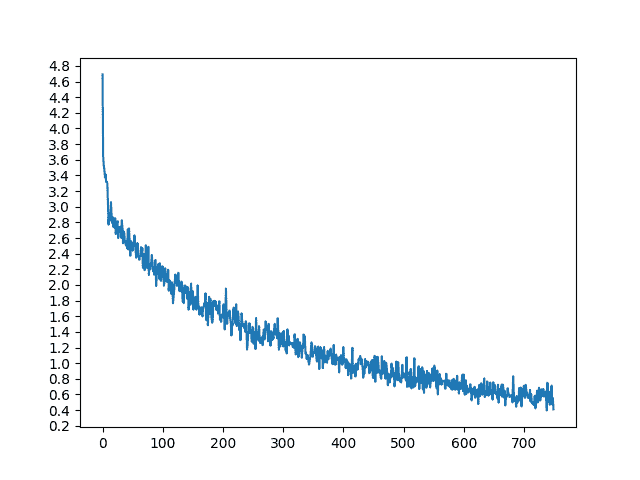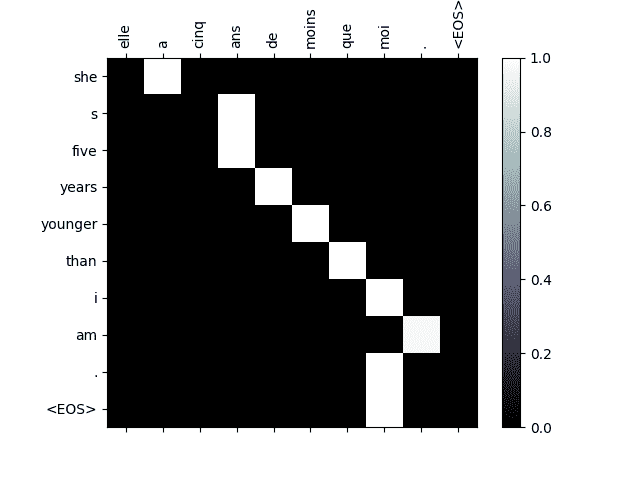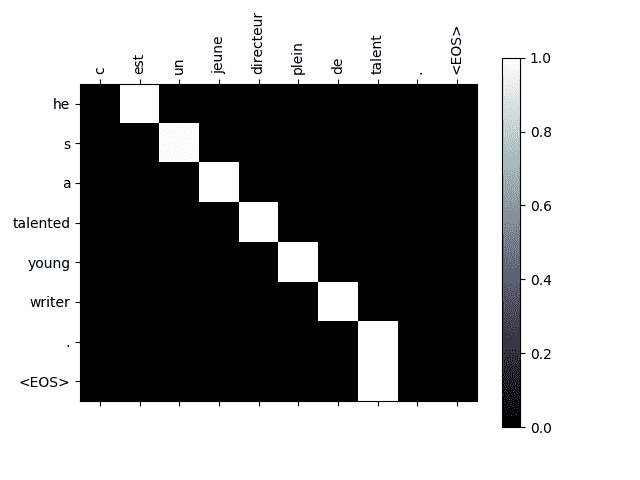从零开始的 NLP:使用序列到序列网络和注意力的翻译
原文:https://pytorch.org/tutorials/intermediate/seq2seq_translation_tutorial.html
作者: Sean Robertson
这是关于“从头开始进行 NLP”的第三篇也是最后一篇教程,我们在其中编写自己的类和函数来预处理数据以完成 NLP 建模任务。 我们希望在完成本教程后,您将继续学习紧接着本教程的三本教程,torchtext如何为您处理许多此类预处理。
在这个项目中,我们将教授将法语翻译成英语的神经网络。
[KEY: > input, = target, < output]> il est en train de peindre un tableau .= he is painting a picture .< he is painting a picture .> pourquoi ne pas essayer ce vin delicieux ?= why not try that delicious wine ?< why not try that delicious wine ?> elle n est pas poete mais romanciere .= she is not a poet but a novelist .< she not not a poet but a novelist .> vous etes trop maigre .= you re too skinny .< you re all alone .
……取得不同程度的成功。
通过序列到序列网络的简单但强大的构想,使这成为可能,其中两个循环神经网络协同工作,将一个序列转换为另一个序列。 编码器网络将输入序列压缩为一个向量,而解码器网络将该向量展开为一个新序列。

为了改进此模型,我们将使用注意力机制,该机制可使解码器学会专注于输入序列的特定范围。
推荐读物:
我假设您至少已经安装了 PyTorch,Python 和张量:
- 安装说明
- 使用 PyTorch 进行深度学习:60 分钟的突击通常开始使用 PyTorch
- [使用示例]学习 PyTorch(../beginner/pytorch_with_examples.html)
- PyTorch(面向以前的 Torch 用户)(如果您以前是 Lua Torch 用户)
了解序列到序列网络及其工作方式也将很有用:
您还将找到有关《从零开始的 NLP:使用字符级 RNN 分类名称》和《从零开始的 NLP:使用字符级 RNN 生成名称》的先前教程。 分别与编码器和解码器模型非常相似。
有关更多信息,请阅读介绍以下主题的论文:
要求
from __future__ import unicode_literals, print_function, divisionfrom io import openimport unicodedataimport stringimport reimport randomimport torchimport torch.nn as nnfrom torch import optimimport torch.nn.functional as Fdevice = torch.device("cuda" if torch.cuda.is_available() else "cpu")
加载数据文件
该项目的数据是成千上万的英语到法语翻译对的集合。
开放数据栈交换上的这个问题使我指向开放翻译站点 ,该站点可从这里下载。更好的是,有人在这里做了一些额外的工作,将语言对拆分为单独的文本文件。
英文对法文对太大,无法包含在仓库中,因此请先下载到data/eng-fra.txt,然后再继续。 该文件是制表符分隔的翻译对列表:
I am cold. J'ai froid.
注意
从的下载数据,并将其提取到当前目录。
与字符级 RNN 教程中使用的字符编码类似,我们将一种语言中的每个单词表示为一个单向向量,或零个大向量(除单个单向索引外)(在单词的索引处)。 与某种语言中可能存在的数十个字符相比,单词更多很多,因此编码向量要大得多。 但是,我们将作弊并整理数据以使每种语言仅使用几千个单词。

我们将需要每个单词一个唯一的索引,以便以后用作网络的输入和目标。 为了跟踪所有这些,我们将使用一个名为Lang的帮助程序类,该类具有单词→索引(word2index)和索引→单词(index2word)字典,以及每个要使用的单词word2count的计数,以便以后替换稀有词。
SOS_token = 0EOS_token = 1class Lang:def __init__(self, name):self.name = nameself.word2index = {}self.word2count = {}self.index2word = {0: "SOS", 1: "EOS"}self.n_words = 2 # Count SOS and EOSdef addSentence(self, sentence):for word in sentence.split(' '):self.addWord(word)def addWord(self, word):if word not in self.word2index:self.word2index[word] = self.n_wordsself.word2count[word] = 1self.index2word[self.n_words] = wordself.n_words += 1else:self.word2count[word] += 1
文件全部为 Unicode,为简化起见,我们将 Unicode 字符转换为 ASCII,将所有内容都转换为小写,并修剪大多数标点符号。
# Turn a Unicode string to plain ASCII, thanks to# https://stackoverflow.com/a/518232/2809427def unicodeToAscii(s):return ''.join(c for c in unicodedata.normalize('NFD', s)if unicodedata.category(c) != 'Mn')# Lowercase, trim, and remove non-letter charactersdef normalizeString(s):s = unicodeToAscii(s.lower().strip())s = re.sub(r"([.!?])", r" \1", s)s = re.sub(r"[^a-zA-Z.!?]+", r" ", s)return s
要读取数据文件,我们将文件拆分为几行,然后将几行拆分为两对。 这些文件都是英语→其他语言的,因此,如果我们要从其他语言→英语进行翻译,我添加了reverse标志来反转对。
def readLangs(lang1, lang2, reverse=False):print("Reading lines...")# Read the file and split into lineslines = open('data/%s-%s.txt' % (lang1, lang2), encoding='utf-8').\read().strip().split('\n')# Split every line into pairs and normalizepairs = [[normalizeString(s) for s in l.split('\t')] for l in lines]# Reverse pairs, make Lang instancesif reverse:pairs = [list(reversed(p)) for p in pairs]input_lang = Lang(lang2)output_lang = Lang(lang1)else:input_lang = Lang(lang1)output_lang = Lang(lang2)return input_lang, output_lang, pairs
由于示例句子有很多,并且我们想快速训练一些东西,因此我们将数据集修剪为仅相对简短的句子。 在这里,最大长度为 10 个字(包括结尾的标点符号),我们正在过滤翻译成“我是”或“他是”等形式的句子(考虑到前面已替换掉撇号的情况)。
MAX_LENGTH = 10eng_prefixes = ("i am ", "i m ","he is", "he s ","she is", "she s ","you are", "you re ","we are", "we re ","they are", "they re ")def filterPair(p):return len(p[0].split(' ')) < MAX_LENGTH and \len(p[1].split(' ')) < MAX_LENGTH and \p[1].startswith(eng_prefixes)def filterPairs(pairs):return [pair for pair in pairs if filterPair(pair)]
准备数据的完整过程是:
- 读取文本文件并拆分为行,将行拆分为偶对
- 规范文本,按长度和内容过滤
- 成对建立句子中的单词列表
def prepareData(lang1, lang2, reverse=False):input_lang, output_lang, pairs = readLangs(lang1, lang2, reverse)print("Read %s sentence pairs" % len(pairs))pairs = filterPairs(pairs)print("Trimmed to %s sentence pairs" % len(pairs))print("Counting words...")for pair in pairs:input_lang.addSentence(pair[0])output_lang.addSentence(pair[1])print("Counted words:")print(input_lang.name, input_lang.n_words)print(output_lang.name, output_lang.n_words)return input_lang, output_lang, pairsinput_lang, output_lang, pairs = prepareData('eng', 'fra', True)print(random.choice(pairs))
出:
Reading lines...Read 135842 sentence pairsTrimmed to 10599 sentence pairsCounting words...Counted words:fra 4345eng 2803['il a l habitude des ordinateurs .', 'he is familiar with computers .']
Seq2Seq 模型
循环神经网络(RNN)是在序列上运行并将其自身的输出用作后续步骤的输入的网络。
序列到序列网络或 seq2seq 网络或编码器解码器网络是由两个称为编码器和解码器的 RNN 组成的模型。 编码器读取输入序列并输出单个向量,而解码器读取该向量以产生输出序列。

与使用单个 RNN 进行序列预测(每个输入对应一个输出)不同,seq2seq 模型使我们摆脱了序列长度和顺序的限制,这使其非常适合两种语言之间的翻译。
考虑一下句子Je ne suis pas le chat noir -> I am not the black cat。 输入句子中的大多数单词在输出句子中具有直接翻译,但是顺序略有不同,例如chat noir和black cat。 由于采用ne/pas结构,因此在输入句子中还有一个单词。 直接从输入单词的序列中产生正确的翻译将是困难的。
使用 seq2seq 模型,编码器创建单个向量,在理想情况下,该向量将输入序列的“含义”编码为单个向量—在句子的 N 维空间中的单个点。
编码器
seq2seq 网络的编码器是 RNN,它为输入句子中的每个单词输出一些值。 对于每个输入字,编码器输出一个向量和一个隐藏状态,并将隐藏状态用于下一个输入字。
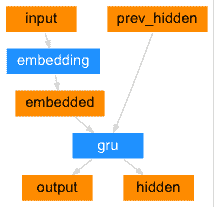
class EncoderRNN(nn.Module):def __init__(self, input_size, hidden_size):super(EncoderRNN, self).__init__()self.hidden_size = hidden_sizeself.embedding = nn.Embedding(input_size, hidden_size)self.gru = nn.GRU(hidden_size, hidden_size)def forward(self, input, hidden):embedded = self.embedding(input).view(1, 1, -1)output = embeddedoutput, hidden = self.gru(output, hidden)return output, hiddendef initHidden(self):return torch.zeros(1, 1, self.hidden_size, device=device)
解码器
解码器是另一个 RNN,它采用编码器输出向量并输出单词序列来创建翻译。
简单解码器
在最简单的 seq2seq 解码器中,我们仅使用编码器的最后一个输出。 该最后的输出有时称为上下文向量,因为它从整个序列中编码上下文。 该上下文向量用作解码器的初始隐藏状态。
在解码的每个步骤中,为解码器提供输入标记和隐藏状态。 初始输入标记是字符串开始<SOS>标记,第一个隐藏状态是上下文向量(编码器的最后一个隐藏状态)。
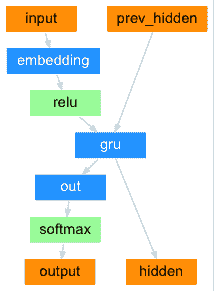
class DecoderRNN(nn.Module):def __init__(self, hidden_size, output_size):super(DecoderRNN, self).__init__()self.hidden_size = hidden_sizeself.embedding = nn.Embedding(output_size, hidden_size)self.gru = nn.GRU(hidden_size, hidden_size)self.out = nn.Linear(hidden_size, output_size)self.softmax = nn.LogSoftmax(dim=1)def forward(self, input, hidden):output = self.embedding(input).view(1, 1, -1)output = F.relu(output)output, hidden = self.gru(output, hidden)output = self.softmax(self.out(output[0]))return output, hiddendef initHidden(self):return torch.zeros(1, 1, self.hidden_size, device=device)
我鼓励您训练并观察该模型的结果,但是为了节省空间,我们将直接努力并引入注意力机制。
注意力解码器
如果仅上下文向量在编码器和解码器之间传递,则该单个向量承担对整个句子进行编码的负担。
注意使解码器网络可以针对解码器自身输出的每一步,“专注”于编码器输出的不同部分。 首先,我们计算一组注意力权重。 将这些与编码器输出向量相乘以创建加权组合。 结果(在代码中称为attn_applied)应包含有关输入序列特定部分的信息,从而帮助解码器选择正确的输出字。
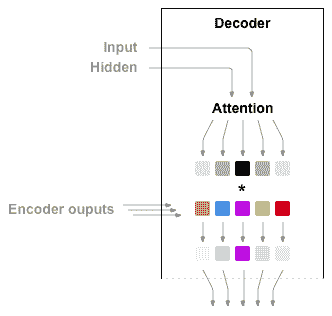
另一个前馈层attn使用解码器的输入和隐藏状态作为输入来计算注意力权重。 由于训练数据中包含各种大小的句子,因此要实际创建和训练该层,我们必须选择可以应用的最大句子长度(输入长度,用于编码器输出)。 最大长度的句子将使用所有注意权重,而较短的句子将仅使用前几个。
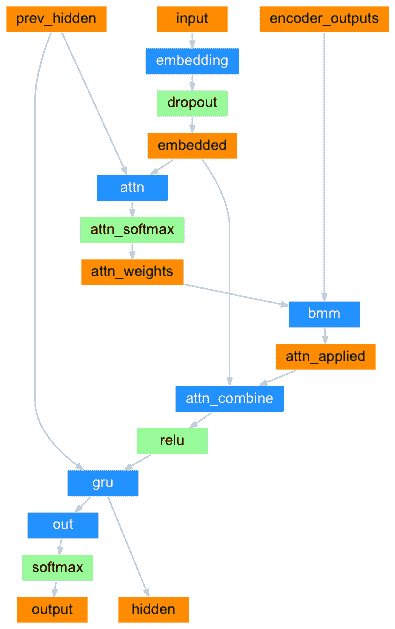
class AttnDecoderRNN(nn.Module):def __init__(self, hidden_size, output_size, dropout_p=0.1, max_length=MAX_LENGTH):super(AttnDecoderRNN, self).__init__()self.hidden_size = hidden_sizeself.output_size = output_sizeself.dropout_p = dropout_pself.max_length = max_lengthself.embedding = nn.Embedding(self.output_size, self.hidden_size)self.attn = nn.Linear(self.hidden_size * 2, self.max_length)self.attn_combine = nn.Linear(self.hidden_size * 2, self.hidden_size)self.dropout = nn.Dropout(self.dropout_p)self.gru = nn.GRU(self.hidden_size, self.hidden_size)self.out = nn.Linear(self.hidden_size, self.output_size)def forward(self, input, hidden, encoder_outputs):embedded = self.embedding(input).view(1, 1, -1)embedded = self.dropout(embedded)attn_weights = F.softmax(self.attn(torch.cat((embedded[0], hidden[0]), 1)), dim=1)attn_applied = torch.bmm(attn_weights.unsqueeze(0),encoder_outputs.unsqueeze(0))output = torch.cat((embedded[0], attn_applied[0]), 1)output = self.attn_combine(output).unsqueeze(0)output = F.relu(output)output, hidden = self.gru(output, hidden)output = F.log_softmax(self.out(output[0]), dim=1)return output, hidden, attn_weightsdef initHidden(self):return torch.zeros(1, 1, self.hidden_size, device=device)
注意
还有其他形式的注意,可以通过使用相对位置方法来解决长度限制问题。 在《基于注意力的神经机器翻译的有效方法》中阅读“本地注意力”。
训练
准备训练数据
为了训练,对于每一对,我们将需要一个输入张量(输入句子中单词的索引)和目标张量(目标句子中单词的索引)。 创建这些向量时,我们会将EOS标记附加到两个序列上。
def indexesFromSentence(lang, sentence):return [lang.word2index[word] for word in sentence.split(' ')]def tensorFromSentence(lang, sentence):indexes = indexesFromSentence(lang, sentence)indexes.append(EOS_token)return torch.tensor(indexes, dtype=torch.long, device=device).view(-1, 1)def tensorsFromPair(pair):input_tensor = tensorFromSentence(input_lang, pair[0])target_tensor = tensorFromSentence(output_lang, pair[1])return (input_tensor, target_tensor)
训练模型
为了训练,我们通过编码器运行输入语句,并跟踪每个输出和最新的隐藏状态。 然后,为解码器提供<SOS>标记作为其第一个输入,为编码器提供最后的隐藏状态作为其第一个隐藏状态。
“教师强制”的概念是使用实际目标输出作为每个下一个输入,而不是使用解码器的猜测作为下一个输入。 使用教师强制会导致其收敛更快,但是当使用受过训练的网络时,可能会显示不稳定。
您可以观察到以教师为主导的网络的输出,这些输出阅读的是连贯的语法,但是却偏离了正确的翻译-直观地,它已经学会了代表输出语法,并且一旦老师说了最初的几个单词就可以“理解”含义,但是首先,它还没有正确地学习如何从翻译中创建句子。
由于 PyTorch 的 Autograd 具有给我们的自由,我们可以通过简单的if语句随意选择是否使用教师强迫。 调高teacher_forcing_ratio以使用更多。
teacher_forcing_ratio = 0.5def train(input_tensor, target_tensor, encoder, decoder, encoder_optimizer, decoder_optimizer, criterion, max_length=MAX_LENGTH):encoder_hidden = encoder.initHidden()encoder_optimizer.zero_grad()decoder_optimizer.zero_grad()input_length = input_tensor.size(0)target_length = target_tensor.size(0)encoder_outputs = torch.zeros(max_length, encoder.hidden_size, device=device)loss = 0for ei in range(input_length):encoder_output, encoder_hidden = encoder(input_tensor[ei], encoder_hidden)encoder_outputs[ei] = encoder_output[0, 0]decoder_input = torch.tensor([[SOS_token]], device=device)decoder_hidden = encoder_hiddenuse_teacher_forcing = True if random.random() < teacher_forcing_ratio else Falseif use_teacher_forcing:# Teacher forcing: Feed the target as the next inputfor di in range(target_length):decoder_output, decoder_hidden, decoder_attention = decoder(decoder_input, decoder_hidden, encoder_outputs)loss += criterion(decoder_output, target_tensor[di])decoder_input = target_tensor[di] # Teacher forcingelse:# Without teacher forcing: use its own predictions as the next inputfor di in range(target_length):decoder_output, decoder_hidden, decoder_attention = decoder(decoder_input, decoder_hidden, encoder_outputs)topv, topi = decoder_output.topk(1)decoder_input = topi.squeeze().detach() # detach from history as inputloss += criterion(decoder_output, target_tensor[di])if decoder_input.item() == EOS_token:breakloss.backward()encoder_optimizer.step()decoder_optimizer.step()return loss.item() / target_length
这是一个帮助函数,用于在给定当前时间和进度% 的情况下打印经过的时间和估计的剩余时间。
import timeimport mathdef asMinutes(s):m = math.floor(s / 60)s -= m * 60return '%dm %ds' % (m, s)def timeSince(since, percent):now = time.time()s = now - sincees = s / (percent)rs = es - sreturn '%s (- %s)' % (asMinutes(s), asMinutes(rs))
整个训练过程如下所示:
- 启动计时器
- 初始化优化器和标准
- 创建一组训练对
- 启动空损失数组进行绘图
然后,我们多次调用train,并偶尔打印进度(示例的百分比,到目前为止的时间,估计的时间)和平均损失。
def trainIters(encoder, decoder, n_iters, print_every=1000, plot_every=100, learning_rate=0.01):start = time.time()plot_losses = []print_loss_total = 0 # Reset every print_everyplot_loss_total = 0 # Reset every plot_everyencoder_optimizer = optim.SGD(encoder.parameters(), lr=learning_rate)decoder_optimizer = optim.SGD(decoder.parameters(), lr=learning_rate)training_pairs = [tensorsFromPair(random.choice(pairs))for i in range(n_iters)]criterion = nn.NLLLoss()for iter in range(1, n_iters + 1):training_pair = training_pairs[iter - 1]input_tensor = training_pair[0]target_tensor = training_pair[1]loss = train(input_tensor, target_tensor, encoder,decoder, encoder_optimizer, decoder_optimizer, criterion)print_loss_total += lossplot_loss_total += lossif iter % print_every == 0:print_loss_avg = print_loss_total / print_everyprint_loss_total = 0print('%s (%d %d%%) %.4f' % (timeSince(start, iter / n_iters),iter, iter / n_iters * 100, print_loss_avg))if iter % plot_every == 0:plot_loss_avg = plot_loss_total / plot_everyplot_losses.append(plot_loss_avg)plot_loss_total = 0showPlot(plot_losses)
绘制结果
使用训练时保存的损失值数组plot_losses,使用 matplotlib 进行绘制。
import matplotlib.pyplot as pltplt.switch_backend('agg')import matplotlib.ticker as tickerimport numpy as npdef showPlot(points):plt.figure()fig, ax = plt.subplots()# this locator puts ticks at regular intervalsloc = ticker.MultipleLocator(base=0.2)ax.yaxis.set_major_locator(loc)plt.plot(points)
评估
评估与训练基本相同,但是没有目标,因此我们只需将解码器的预测反馈给每一步。 每当它预测一个单词时,我们都会将其添加到输出字符串中,如果它预测到EOS标记,我们将在此处停止。 我们还将存储解码器的注意输出,以供以后显示。
def evaluate(encoder, decoder, sentence, max_length=MAX_LENGTH):with torch.no_grad():input_tensor = tensorFromSentence(input_lang, sentence)input_length = input_tensor.size()[0]encoder_hidden = encoder.initHidden()encoder_outputs = torch.zeros(max_length, encoder.hidden_size, device=device)for ei in range(input_length):encoder_output, encoder_hidden = encoder(input_tensor[ei],encoder_hidden)encoder_outputs[ei] += encoder_output[0, 0]decoder_input = torch.tensor([[SOS_token]], device=device) # SOSdecoder_hidden = encoder_hiddendecoded_words = []decoder_attentions = torch.zeros(max_length, max_length)for di in range(max_length):decoder_output, decoder_hidden, decoder_attention = decoder(decoder_input, decoder_hidden, encoder_outputs)decoder_attentions[di] = decoder_attention.datatopv, topi = decoder_output.data.topk(1)if topi.item() == EOS_token:decoded_words.append('<EOS>')breakelse:decoded_words.append(output_lang.index2word[topi.item()])decoder_input = topi.squeeze().detach()return decoded_words, decoder_attentions[:di + 1]
我们可以从训练集中评估随机句子,并打印出输入,目标和输出以做出一些主观的质量判断:
def evaluateRandomly(encoder, decoder, n=10):for i in range(n):pair = random.choice(pairs)print('>', pair[0])print('=', pair[1])output_words, attentions = evaluate(encoder, decoder, pair[0])output_sentence = ' '.join(output_words)print('<', output_sentence)print('')
训练和评估
有了所有这些辅助函数(看起来像是额外的工作,但它使运行多个实验更加容易),我们实际上可以初始化网络并开始训练。
请记住,输入语句已被大量过滤。 对于这个小的数据集,我们可以使用具有 256 个隐藏节点和单个 GRU 层的相对较小的网络。 在 MacBook CPU 上运行约 40 分钟后,我们会得到一些合理的结果。
注意
如果运行此笔记本,则可以进行训练,中断内核,评估并在以后继续训练。 注释掉编码器和解码器已初始化的行,然后再次运行trainIters。
hidden_size = 256encoder1 = EncoderRNN(input_lang.n_words, hidden_size).to(device)attn_decoder1 = AttnDecoderRNN(hidden_size, output_lang.n_words, dropout_p=0.1).to(device)trainIters(encoder1, attn_decoder1, 75000, print_every=5000)
出:
2m 6s (- 29m 28s) (5000 6%) 2.85384m 7s (- 26m 49s) (10000 13%) 2.30356m 10s (- 24m 40s) (15000 20%) 1.98128m 13s (- 22m 37s) (20000 26%) 1.708310m 15s (- 20m 31s) (25000 33%) 1.519912m 17s (- 18m 26s) (30000 40%) 1.358014m 18s (- 16m 20s) (35000 46%) 1.200216m 18s (- 14m 16s) (40000 53%) 1.083218m 21s (- 12m 14s) (45000 60%) 0.971920m 22s (- 10m 11s) (50000 66%) 0.887922m 23s (- 8m 8s) (55000 73%) 0.813024m 25s (- 6m 6s) (60000 80%) 0.750926m 27s (- 4m 4s) (65000 86%) 0.652428m 27s (- 2m 1s) (70000 93%) 0.600730m 30s (- 0m 0s) (75000 100%) 0.5699
evaluateRandomly(encoder1, attn_decoder1)
出:
> nous sommes desolees .= we re sorry .< we re sorry . <EOS>> tu plaisantes bien sur .= you re joking of course .< you re joking of course . <EOS>> vous etes trop stupide pour vivre .= you re too stupid to live .< you re too stupid to live . <EOS>> c est un scientifique de niveau international .= he s a world class scientist .< he is a successful person . <EOS>> j agis pour mon pere .= i am acting for my father .< i m trying to my father . <EOS>> ils courent maintenant .= they are running now .< they are running now . <EOS>> je suis tres heureux d etre ici .= i m very happy to be here .< i m very happy to be here . <EOS>> vous etes bonne .= you re good .< you re good . <EOS>> il a peur de la mort .= he is afraid of death .< he is afraid of death . <EOS>> je suis determine a devenir un scientifique .= i am determined to be a scientist .< i m ready to make a cold . <EOS>
可视化注意力
注意力机制的一个有用特性是其高度可解释的输出。 因为它用于加权输入序列的特定编码器输出,所以我们可以想象一下在每个时间步长上网络最关注的位置。
您可以简单地运行plt.matshow(attentions)以将注意力输出显示为矩阵,其中列为输入步骤,行为输出步骤:
output_words, attentions = evaluate(encoder1, attn_decoder1, "je suis trop froid .")plt.matshow(attentions.numpy())
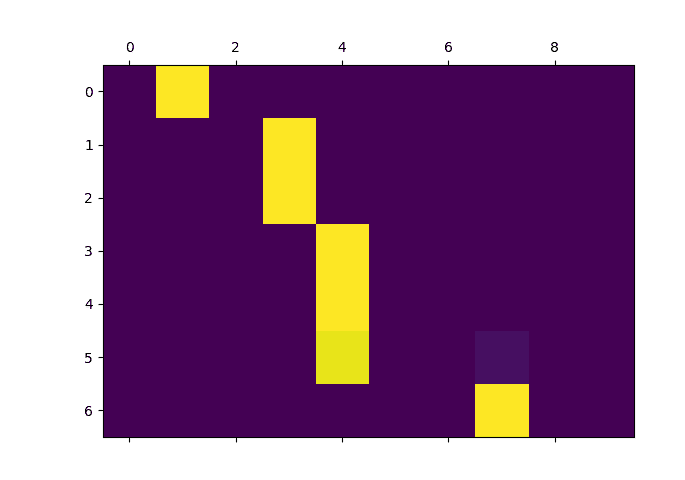
为了获得更好的观看体验,我们将做一些额外的工作来添加轴和标签:
def showAttention(input_sentence, output_words, attentions):# Set up figure with colorbarfig = plt.figure()ax = fig.add_subplot(111)cax = ax.matshow(attentions.numpy(), cmap='bone')fig.colorbar(cax)# Set up axesax.set_xticklabels([''] + input_sentence.split(' ') +['<EOS>'], rotation=90)ax.set_yticklabels([''] + output_words)# Show label at every tickax.xaxis.set_major_locator(ticker.MultipleLocator(1))ax.yaxis.set_major_locator(ticker.MultipleLocator(1))plt.show()def evaluateAndShowAttention(input_sentence):output_words, attentions = evaluate(encoder1, attn_decoder1, input_sentence)print('input =', input_sentence)print('output =', ' '.join(output_words))showAttention(input_sentence, output_words, attentions)evaluateAndShowAttention("elle a cinq ans de moins que moi .")evaluateAndShowAttention("elle est trop petit .")evaluateAndShowAttention("je ne crains pas de mourir .")evaluateAndShowAttention("c est un jeune directeur plein de talent .")
出:
input = elle a cinq ans de moins que moi .output = she s five years younger than i am . <EOS>input = elle est trop petit .output = she s too loud . <EOS>input = je ne crains pas de mourir .output = i m not scared to die . <EOS>input = c est un jeune directeur plein de talent .output = he s a talented young writer . <EOS>
练习
- 尝试使用其他数据集
- 另一对语言
- 人机 → 机器(例如 IOT 命令)
- 聊天 → 回复
- 问题 → 答案
- 用预训练的单词嵌入(例如 word2vec 或 GloVe)替换嵌入
- 尝试使用更多的层,更多的隐藏单元和更多的句子。 比较训练时间和结果。
- 如果您使用翻译对,其中成对具有两个相同的词组(
I am test \t I am test),则可以将其用作自编码器。 尝试这个:- 训练为自编码器
- 仅保存编码器网络
- 从那里训练新的解码器进行翻译
脚本的总运行时间:(30 分钟 37.929 秒)
下载 Python 源码:seq2seq_translation_tutorial.py
下载 Jupyter 笔记本:seq2seq_translation_tutorial.ipynb
由 Sphinx 画廊生成的画廊

